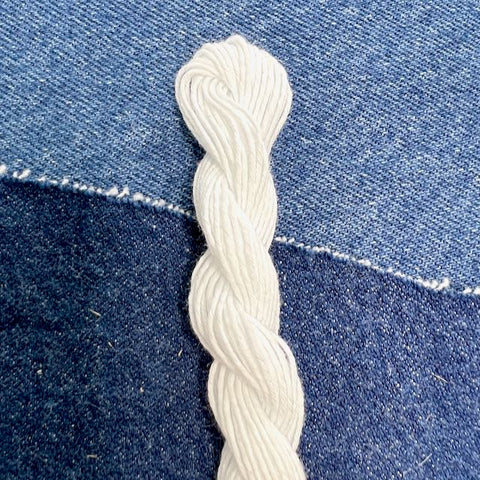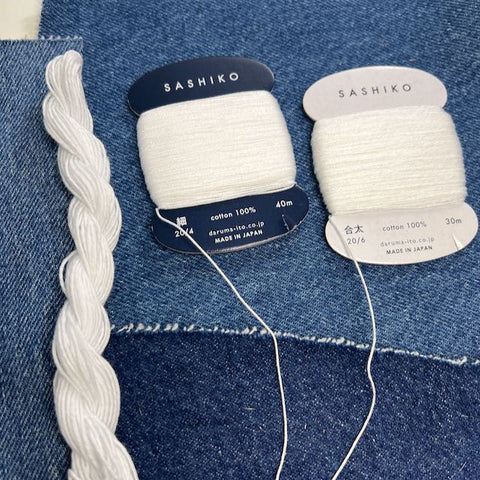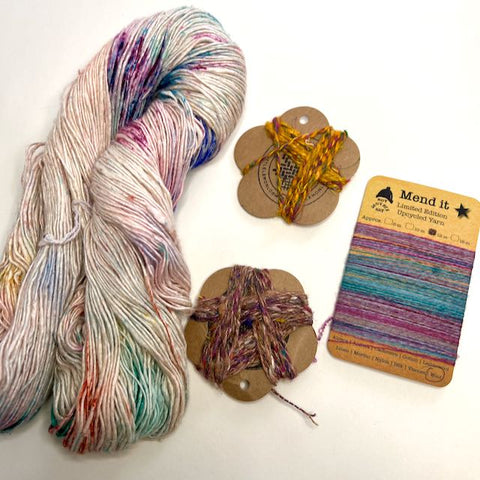
If you are just getting into mending or needlecraft, you have probably noticed that there are a lot of different types of thread and yarn.
The good news is, there is a lot of overlap when it comes to what materials are used for which type of stitching. This also means that as a beginner, it might be confusing to know how to choose the type of thread or yarn to use for your specific project.
Today, I am hoping to demystify some of this for you. I’ll explain different types of thread, and also yarn (I think it’s fine to use these terms interchangeably), and the terms or numbers you might see when looking for materials to use for your project. Many of these types of thread are sold in my shop, which I will also link to. Sound good?
When you are just getting started, and the options are endless, my advice is to start simple. If you are mending, find yourself some embroidery thread or sashiko thread and you can complete almost any mend with that single type of thread.
The more you mend, the more comfortable you will become experimenting with different types of thread. As your experience grows, you’ll notice how different threads can affect the both the outcome and aesthetic of a mend.
Sewing Thread
What is it? Sewing thread is a staple for every sewing kit. It comes in varying fibers from linen, silk, or cotton to polyester and blends of poly and natural fibers for added strength.
What are the different sizes? Sewing thread is more or less a standard thickness. There are specialty sewing threads that are thicker for commercial and heavy duty purposes.
How is it used for mending? Use sewing thread to sew a button back on, other fine hand sewn repairs, or for use in your sewing machine. Sewing thread is too thin to be of much use when it comes to hand stitching on thicker fabric like denim.

Pearl Cotton/ Perle Cotton
What is it? This type of thread is made up of tightly twisted, indivisible 100% cotton strands that have been mercerized. Mercerization is a chemical process that increases the ability of the thread to take dye, and also decreases its absorbency. This process also increases the strength of the thread. It is noticeably shiny in appearance. Pearl cotton is sold as skeins or balls.
What are the different sizes? Pearl Cotton is available in different sizes (3, 5, 8, 12, 16). The thickest size is #3 and the thinnest size is #16.
How is it used for mending? For mending and embroidery, I use #8 in my mending. For most dense fabrics, #5 is a little too thick. I don't use pearl cotton in my darning, because it doesn't felt together nicely like yarn or un-mercerized thread.

Sashiko Thread
What is it? Sashiko Thread is a specialty Japanese thread, suited for hand stitching. It is not mercerized, and has a softer feel and look.
What are the different sizes? Sashiko thread comes in a small variety of sizes, thin or thick. Daruma, a carded sashiko thread is sized with the term, 20/4 or 20/6. The thinner, or 20/4 means that there are 4 strands tightly woven together to create a single strand, and 20/6 is thicker, with 6 strands woven together. Olympus makes skeins of sashiko thread that is closer in size to the thicker Daruma thread.
How is it used for mending? I love the texture of sashiko thread, and use it often in visible mending for denim or wovens, for darning mid-weight socks, and occasionally when darning a sweater.

Crochet Cotton
What is it? Crochet cotton is another type of thread that is similar to both pearl cotton and sashiko thread in thickness, and it is also cotton thread. It is mercerized, though is much less shiny than pearl cotton. As the name implies, crochet cotton is used to crochet fine pieces, like lace.
What are the different sizes? There are 3 sizes of crochet cotton. Size 3, which is thicker, size 10, which is similar to a #8 pearl cotton and sashiko thread, and finer in size #20.
How is it used for mending? Crochet cotton can be used in the same projects as pearl cotton-mainly mending denim and other wovens, or used for hand embroidery. I love crochet cotton because it is easily found at secondhand shops, making it a good economical and better environmental choice.

Embroidery Thread
What is it? Embroidery thread or floss is made from 6 strands of cotton thread, that can be easily separated for use in projects.
What are the different sizes? There is only 1 size of embroidery floss, though you can adjust the thickness by using more or fewer strands.
How is it used for mending? Embroidery floss can be used in both darning and mending, though because it is stranded, and wants to be divided, it may not stay looking as tidy in projects.
Yarn
Yarn is less familiar to me. Often, when I’m thrifting I will find leftover yarn from projects without labels, or gleefully come across bags stuffed full of vintage needlepoint yarn at creative reuse shops.
Before I started teaching about darning, I didn’t give these different types of yarns much thought other than finding a thickness that worked for a particular project. But then the questions started coming in, so I put my research hat on, and combed through some explanations on yarn sizing. I have included a list of my sources at the end of this post.
What is it? Yarn and thread can be used interchangeably, but for use here, I'm referring to the material that a sweater or knit hat is made from. Yarn is spun, interlocking the fibers together. The fibers may be looser or very tight, and made from natural fibers such as wool, linen, cotton, bamboo, hemp, alpaca, even cat hair! Yarn can also be made from synthetic material, or a blend of natural and synthetic.
What are the different sizes? Yarn sizing has to do with WPI, or wraps per inch, so however many times it takes the yarn to wrap around a ruler, laid side by side, to get to an inch.
First, let’s talk about the big skeins or balls of yarn you would find at a craft or yarn shop.
There is a standard measurement of yarn set by the Craft Yarn Council, ranging from size 0-7. Other terms used are in parenthesis.
0=Lace (fingering)
1=Super Fine (sock, fingering, baby)
2=Fine (sport, baby)
3=Light (DK, light worsted)
4=Medium (worsted, afghan, aran)
5=Bulky (chunky, craft, rug)
6=Super Bulky (super bulky, roving)
7=Jumbo (roving)

How is it used for mending? I typically use for darning sweaters is the 0-3 range. However, depending on the type of repair, you might match the type of yarn chosen for repair with that that the sweater was initially made from, particularly if a hand knit sweater. Yarn is not used for mending jeans and wovens.

Specialty Threads
There are also various types of specialty threads that may be upcycled from textiles, repurposed and overdyed, or even hand spun, which do not fit neatly into the categories above. One examples of these are Mend-It's, which are upcycled from sweaters, and then dyed and carded.
Weaving yarn is in its own group, and is unwashed. Weaving yarn is sized by weight, calculated by how many yards of yarn is spun from 1 lb of fiber. If you see larger cones of more natural looking fibers, this is likely weaving yarn.
Crewel and more These small skeins (similar to the size of embroidery floss skeins) are made for needlepoint, tapestry, crewel or Persian yarn, and also great to use for darning. Some of these smaller skeins are made up of single strands, and some of multiple strands.

All of the the threads mentioned in this post can be found in almost every hue, tint and shade. Using variegated threads in your mending are also an easy way to mix color. Variegated thread colors change within the same thread, giving your mend a more complex appearance with no added skill or effort. I love using variegated thread in both darning and embroidery style stitched patterns.
I hope this thread breakdown has given you more insight into the world of thread choices that await you. The more you work with different types of thread, the less intimidating it becomes to decide what will work for any particular project.
Sources
craftyarncouncil.com/standards/yarnweightsystem
sarahmaker.com/yarn-weights-guide/
woolery.com/yarn-weights-helpful-explanation/
worldofneedlepoint.com/guide-to-needlepoint-yarns-and-threads/




This is so helpful! I’m newer to visible mending and darning so this is a nice starting point. Thank you for sharing your knowledge.
Hi Erin,
Thanks for the helpful share about how to choose the right thread for mending. My question is about lightfastness. What threads are the best to retain their colors over time?
Thank you :)
Coco
Erin, thank you so much for your demystifying article. I’m going to archive it and refer to it often, I’m sure. Truly, it was most helpful. I’ve been sewing, crafting, and mending many years and many times have been disappointed with results, I imagine having this article (knowledge) in my back pocket would have helped. Thank you again and keep up the good work.
K
This is SO helpful! I’m going to print it and use as a resource. One of my challenges as I start learning how to do creative stitching is threading the needle! How large a needle can I use or do you have advice/ideas about how to get thicker thread through a needle? I’d like to use more than 2strands of embroidery floss. I also bought some beautiful variegated DMC 5 but can’t thread it. Thanks!
This is SO helpful! I’m going to print it and use as a resource. One of my challenges as I start learning how to do creative stitching is threading the needle! How large a needle can I use or do you have advice/ideas about how to get thicker thread through a needle? I’d like to use more than 2strands of embroidery floss. I also bought some beautiful variegated DMC 5 but can’t thread it. Thanks!